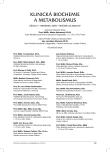Hemolysis index as a tool for determination of free hemoglobin in plasma.
Authors:
J. Komrsková 1; Z. Kubíček 1; J. Franeková 1,2; A. Jabor 1,2
Authors‘ workplace:
Pracoviště laboratorních metod, Institut klinické a experimentální medicíny, Praha
1; 3. lékařská fakulta UK, Praha
2
Published in:
Klin. Biochem. Metab., 26, 2018, No. 4, p. 173-177
Overview
Objective:
Implementation of a laboratory test of free hemoglobin in plasma into routine laboratory practice using a calculation method based on hemolysis index (HI). The test should be available 24/7 and quality control of this method should be ensured.
Design:
Original Article.
Settings:
Institute for Clinical and Experimental Medicine, Vídeňská 1958/9, 140 21 Praha 4
Materials and methods:
The method was calibrated using in-house calibration standards. The patients’ samples were compared to a spectrophotometric method according to Fairbanks [1] and to the HI-based method (measured on the automated analyzer Cobas 6000, Roche) using the Passing-Bablok regression. The external quality assessment (EQA) samples (INSTAND e.V.) and the in-house internal quality control (IQC) samples, prepared just as the calibration standards, were measured in the same way. Yields relative to target (or theoretical) hemoglobin plasma concentrations were calculated for the both types of samples.
Results:
The linear regression equation for calculation of free hemoglobin in plasma [free Hb (mg/l) = 11.41*HI+21.1] was obtained by calibration. This formula was utilized to compare patients’ samples to the Fairbanks procedure [1] using Passing-Bablok regression (intercept 45.9 mg/L; slope 1.28). Recovery of the Fairbanks method [1] relative to the target values of the EQA samples was 100.8 %. Recovery of the HI-based method was only 71.1%. The HI-based method correlated with theoretical concentration of hemoglobin; the spectrophotometric method by Fairbanks [1] did not.
Conclusion:
The free hemoglobin calculation method utilizing HI values is an easy-to-use, low-cost and fast method that can be available to clinical departments 24/7. The results are sufficient for timely identification of intravascular hemolysis. There are discrepant results of compared methods in patient samples, but we do not consider the bias as significant because of higher limit for organs damage (up 400 mg/l), which is caused by mechanical hemolysis. However, the EQA samples correlate only with the Fairbanks method [1], due to different matrix properties of these samples, and therefore cannot be used for the HI-based method. Ensuring traceability between spectrophotometrically measured EQA samples and the HI-based method by means of patients’ samples has been the only option for trueness verification of the implemented method so far.
Keywords:
free hemoglobin, hemolysis index, hemolysis.
Sources
1. Fairbanks, V. F., Ziesmer, S. C., O’Brien, P. C. Me-thods for measuring plasma hemoglobin in micromolar concentration compared. Clin. Chem. 1992, 38(1), p. 132-40.
2. Thomas, L. Clinical Laboratory Diagnostics: Use and Assessment of Clinical Laboratory Results. Frankfurt am Main: TH-Books, 1998, 1527 s. ISBN 3-9805215-4-0.
3. Schaer, D. J., Buehler, P. W., Alayash, A. I., Belcher, J. D., Vercellotti, G. M. Hemolysis and free hemoglobin revisited: exploring hemoglobin and hemin scavengers as a novel class of therapeutic proteins. Blood 2013, 121(8), p. 1276-84.
4. COBI-CD, Compendium of Background Information, Roche Diagnostics, verze 1.0.
5. Petrova, D. T., Cocisiu, G. A., Eberle, C., et al. Can the Roche hemolysis index be used for automated determination of cell-free hemoglobin? A comparison to photometric assays. Clin. Biochem. 2013, 46(13-14), p. 1298-301.
6. Goyal, M. M., Basak, A. Estimation of plasma haemoglobin by a modified kinetic method using o-tolidine. Indian J Clin. Biochem. 2009, 24(1), 36-41.
7. Silbernagl, S., Despopoulos, A. Atlas fyziologie člověka. Praha: Grada, 2016, 448 s. ISBN 978-80-247-4271-7
8. Lammers, M., Gressner, A. M. Immunonephelometric quantification of free haemoglobin. J Clin. Chem. Clin. Biochem. 1987, 25(6), p. 363-7.
9. Fořtová, H., Kodíček, M., Spalová, H. Praktické možnosti stanovení nízkých koncentrací hemoglobinu v plazmě. Klin. Biochem. Metab. 1993, 1(22), No. 2, p. 79-83.
10. Cripps, C. M. Rapid method for the estimation of plasma haemoglobin levels. J Clin. Pathol. 1968, 21(1), p. 110-2.
11. Porter, G. A. Spectrophotometric method for quantitative plasma hemoglobin resulting from acute hemolysis. J Lab. Clin. Med. 1962, 60, p. 339-48.
12. Shinowara, G. Y. Spectrophotometric studies on blood serum and plasma; the physical determination of hemoglobin and bilirubin. Am. J Clin. Pathol. 1954, 24(6), p. 696-710.
13. INSTAND Program of External Quality Assessment. Schemes in Medical Laboratories. Düsseldorf, Germany: INSTAND e.V., 2018, 140 s. Dostupný z WWW: https://www.instand-ev.de/fileadmin/uploads/Ringversuche/INSTAND_Katalog_2018_EN.pdf
Labels
Clinical biochemistry Nuclear medicine Nutritive therapistArticle was published in
Clinical Biochemistry and Metabolism

2018 Issue 4
Most read in this issue
- Hyponatremia – Frequency, Causes, Pathobiochemistry, Clinics and Therapy.
- Hemolysis index as a tool for determination of free hemoglobin in plasma.
- Zeman M.: Refeeding syndrome after paleodiet
- Kidney stones - effect of indapamide treatment – a case study
